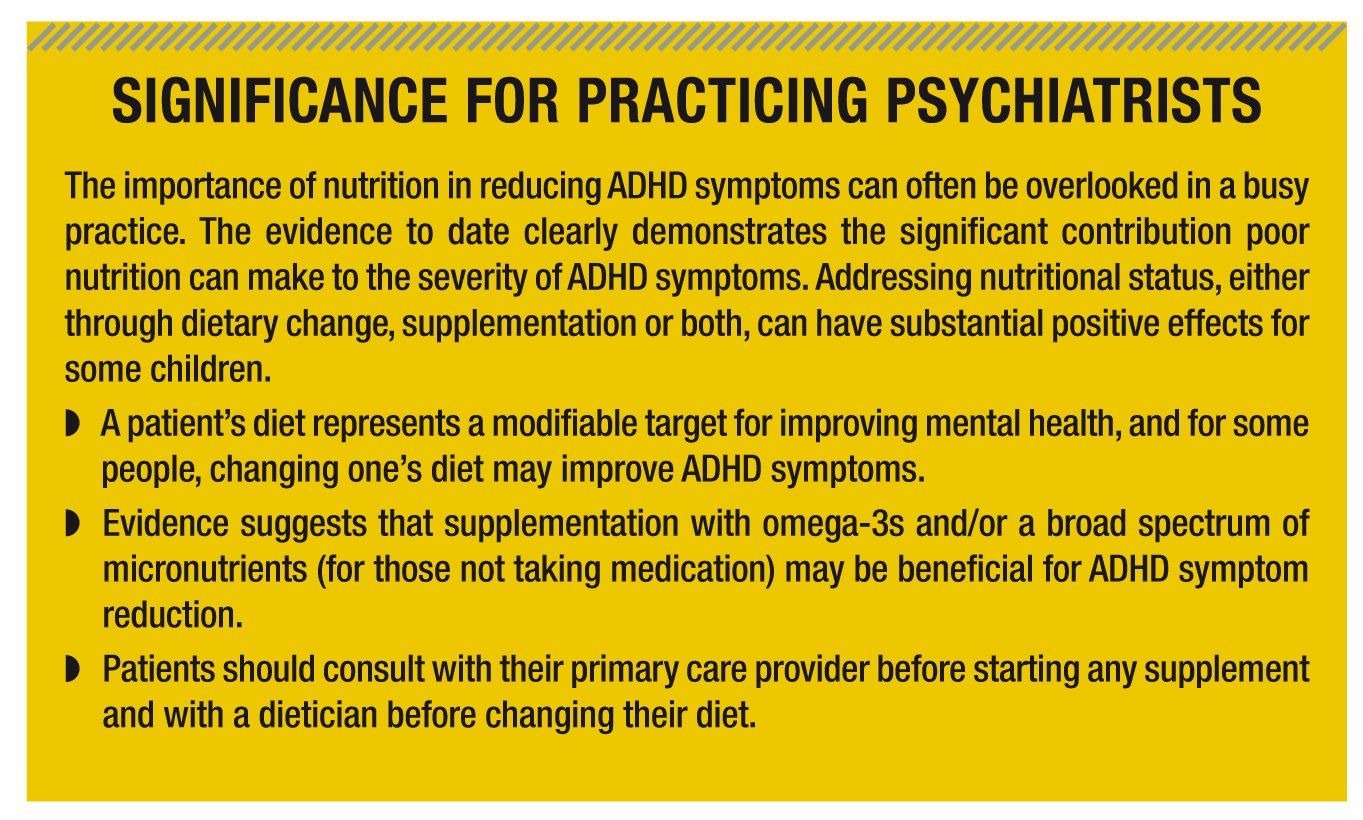Publication
Article
Psychiatric Times
Do Diet and Nutrition Affect ADHD? Facts and Clinical Considerations
Author(s):
This article examines the contributory role of diet on ADHD symptoms, including how the elimination of certain foods and additives, as well as the consumption of other foods or nutrients, may impact symptoms.
Africa Studio/Shutterstock

SIGNIFICANCE FOR PRACTICING PSYCHIATRISTS

Clinical Tips

Psychiatrists and other mental health professionals are often asked about the role that diet and nutrition play in ADHD etiology and symptom management. This article examines the contributory role of diet on ADHD symptoms, including how the elimination of certain foods and additives, as well as the consumption of other foods or nutrients, may impact symptoms. The role of nutrient supplementation will be reviewed as well, including the potential mechanisms behind why nutrient supplementation may alleviate some symptoms of the disorder.
The role of elimination diets
Elimination diets have been a consideration in managing ADHD symptoms since the 1970s, beginning with the work of Feingold,1 a pediatric allergist, who recommended eliminating food additives such as dyes and preservatives alongside other foods. Feingold theorized that highly antigenic foods (those often associated with allergies and intolerance) negatively influenced the behavior of children with ADHD (hyperkinesis). Despite anecdotal reporting from many families that the elimination of these foods, based on Feingold’s diet, significantly improved their children’s behavior, initial results from effectiveness studies were inconclusive. In the decade that followed these mixed results, stimulant medication came to the fore as a primary treatment for ADHD, which likely contributed to diminished scientific interest in dietary interventions for ADHD.
Over the past two decades there has been renewed scientific interest in dietary interventions for ADHD. In randomized, double-blind, placebo-controlled studies from the University of Southampton, the consumption of food coloring and preservatives was found to be associated with hyperactive behavior in community samples of 3 year olds and 8 and/or 9 year olds.2,3 Although the study comprises a community rather than a clinical sample, the findings led to a reconsideration of the theoretical underpinnings of Feingold’s diet, at least for some hyperactive children.
Further investigation into the genotypes of the Southampton study participants highlighted possible mechanisms that may contribute to individual responses to food additives. Stevenson and colleagues4 suggest that in children with ADHD, histamine gene polymorphisms associated with alterations in the histaminergic system, explain differential responses to certain food additives.
Meta-analyses have shown that for about 8% of children, elimination of certain foods, additives, and food colors resulted in significant improvement in ADHD symptoms. In response to these findings, several European nations have banned the use of certain artificial food colors due to the strength of the evidence that these colors may have adverse effects on childhood behavior, while offering no nutritional value to the child. It is important to note though that in the study by Nigg and colleagues,6 effects were not significant on teachers’ reports and observer measures.
Overall, the clinical utility of removing food dyes and additives should be weighed against difficulty and expenses. Ideally ingredients such as food dyes and preservatives should be minimized in the food supply rather than expecting families to navigate the exclusion of these food additives, especially dyes. While removing food dyes and additives requires patient burden, these ingredients confer no health benefit and are purely “aesthetic,” used by food manufacturers to entice children to eat more processed food.
One study that went further than investigating the effects of food additives and colors on ADHD symptoms is The Impact of Nutrition on Children with ADHD (INCA) study.7 The study also included the effects of full oligoantigenic diets or a “few foods diet” (the elimination of other potential allergens as well, such as wheat, dairy, certain meats, carbohydrates, fruits, and vegetables). In few foods diets, food restrictions remain for some weeks (2-5 weeks) in which the individual is only allowed to eat a few different hypo-allergenic foods (eg, rice, turkey, lettuce, pears, water), then a broader range of foods are gradually reintroduced.
Administering such diets is problematic because the food restrictions render blinding difficult. In addition, providing support or guidance for such an intervention is outside the expertise for most mental health professionals. For families, this level of dietary restriction can be challenging to maintain. Nevertheless, the INCA study demonstrated significant symptom reduction in individuals with ADHD. The mechanisms are uncertain however, as the study was unable to demonstrate a relationship between immunoglobulin E (IgE) and IgG levels and exposure to the highly restrictive diet.
An effect size of 0.29 was reported for the elimination/oligoantigenic diets across 6 controlled trials that included 195 participants.6 Findings indicate that about one-third of the children with ADHD had an excellent (>40% symptom reduction) response. However, according to Catalá-López and colleagues,8 the elimination diet research is significantly hampered by methodological heterogeneity rendering small or imprecise effect sizes that need to be interpreted with caution. While few foods diets may result in behavioral and/or cognitive changes for a minority of children with ADHD, identifying the subgroup for whom this treatment works is proving elusive and again, the diet represents a significant burden to families.
Casein or gluten free diets
Despite anecdotal reports of an increased prevalence of food allergies among ADHD patients, systematic reviews examining the association between ADHD and dairy or casein intolerance have been inconclusive. Similarly, despite an association between gluten intolerance and hyperactivity symptoms in those with celiac disease, evidence does not support a clear link between ADHD and celiac disease.9 As part of oligoantigenic diets, behavioral improvements have been found from the exclusion of dairy and wheat/gluten. However, it is not clear whether these effects are the result of removing these or other antigenic foods themselves, or due to secondary factors such as an alteration of gut microbiota.
The role of sugar
Consideration of sugar’s role in the expression of ADHD symptoms arose from observations of increased hyperactivity among children after consuming sugar. Cross-sectional studies show a linear association between consumption of sugar-containing soft drinks and hyperactivity.10 However, given the context for this association (eg, children’s birthday parties), the true relationship between sugar consumption and hyperactivity may be influenced by the environmental and situational factors in which large amounts of sugar are consumed.
While it is reasonably well established that short-term consumption of sugar is not associated with ADHD symptoms, Johnson and colleagues11 theorize that chronic overconsumption of sugar may influence dopamine regulation and therefore may be an etiological factor in ADHD. Indeed, the American Academy of Pediatrics recommends limiting sugar to less than 10% of total calories per day (roughly 6 teaspoons per day for children ages 2 to 19 years) to support good mental and physical health.
Whole diet approaches
Many families ask whether simply eating a healthy diet will help ADHD symptoms. For some, that may be true. Certain dietary patterns have been associated with ADHD symptoms. Adolescents who consume a Western diet, characterized by a high intake of refined carbohydrates, sugars and sodium, total and saturated fats, and lower intake of omega-3 fatty acids, fiber and folate, showed a higher prevalence of ADHD, even after controlling for confounding variables.12 The observed relationship between ADHD and poor diet quality may be bi-directional in that individuals with ADHD may make poorer dietary choices compared with non-affected peers as a result of higher impulsivity and reward preference.
While eating a healthy diet is one consideration, another factor to consider is the nutrient composition of the foods consumed in the 21st century compared with 50 or 100 years ago. The mineral composition of 20 fruits and vegetables in the 1940s compared with the same fruits and vegetables in the 1990s, was significantly lower.13 High yield crops produced with fertilizers, pesticides, and heavy irrigation may lead to significant soil depletion of these nutrients.
For some families, eating a healthy diet is difficult because of inaccessibility of supermarkets that sell unprocessed foods including fresh produce. “Food deserts” are geographic regions where residents, typically in lower socioeconomic brackets, are limited by the selection available at convenience stores and fast food restaurants. In food deserts, dietary options tend to be limited to processed foods that are high in salt, unhealthy fat, and sugar, with low or no availability of fresh fruit, vegetables or whole grains. As such, even well-meaning parents may struggle to address poor diet. This is where the supplementation research may be of particular interest.
Supplementation with individual nutrients
Lower serum levels of omega-3 and omega-6 in children with ADHD suggest either poorer absorption and/or increased metabolism of polyunsaturated fatty acids (PUFAs). Because of their neurophysiological properties, PUFAs may have a protective or modulatory role in neurological processes including neural signaling, synaptic functioning, and neurotransmitter regulation.
Findings from controlled treatment trials of PUFAs in individuals with ADHD indicate that the symptom changes appear to be significant for a sizeable minority, regardless of the overall small effect sizes for this population. Given that research has shown a reduction in omega-3 fatty acids in children with ADHD and a modest improvement (effect size estimates range from 0.18 to 0.31) in symptoms, it is a reasonable option alongside established therapies.14
The results for other micronutrient supplements such as single vitamins, minerals, amino acids have been inconsistent. A number of researchers have concluded that single nutrient interventions may not be effective for improving ADHD symptoms, perhaps due to the complex interplay between aberrant biochemical pathways in people with ADHD. Considering the range of nutrients that are necessary to sustain a highly metabolically active brain, it is logical to supplement with a combination of nutrients to provide the building blocks required for optimal brain functioning.
Multi-ingredient, broad spectrum micronutrients
Historically, trials of broad spectrum micronutrients (BSM) in the treatment of ADHD have been surrounded by controversy, likely resulting from the administration of very small doses resulting in nonsignificant effect; or mega-doses, leading to problems with toxicity and adverse effects. However, over the last decade a number of trials have utilized BSM in doses that were both adequate enough to treat core ADHD symptoms, and also below toxic levels. Although the trials varied in BSM composition and duration, all resulted in significant improvements in behavioral functioning, including core ADHD symptoms and/or emotional regulation. Reassuringly, very few adverse effects (AEs) were reported, with no differences in AEs between active and placebo treatment.15
Two randomized clinical trials demonstrated significant improvements with small to medium effect sizes in multiple areas of functioning, including ADHD symptoms (particularly inattention) as well as emotional regulation for adults and children with ADHD.16,17 Follow up at one year of the adult participants with ADHD revealed that among the 20% who continued with the BSM formula, ADHD symptoms were in the nonclinical range-a significant improvement from baseline.18
Regarding the effectiveness of BSM for ADHD, it is important to note that the majority of BSM trials for ADHD have been conducted with medication-free individuals. While, caution is warranted in using BSM as an adjunctive treatment to stimulant medication, early research suggests that in some cases, medication doses may need to be reduced (with physician monitoring) when taken alongside nutrients.19 Reduction in dose is thought to be possible because of the nutrients’ potentiation of the medication, hence the caution for combining and the need for medical oversight.
Although the multi-ingredient trials described here have all shown promise, replication and longer-term studies, including clinical populations who are taking medication, are required to make more definitive recommendations about efficacy. No significant safety concerns were raised in the trials, which suggests that at least in the short-term, the nutrients are not having a negative effect on functioning or blood markers of general health (eg, hematology, liver or kidney functioning). Adverse effects such as gastrointestinal upset are typically mild, short-lived, and alleviated by taking pills with food and water.
Conclusion
A growing body of research suggests that diet, both the elimination of certain additives and/or allergens, and the consumption of nutrient-rich foods, plays a role in ADHD. The effects of these dietary changes are small, and may be due to inter-individual differences such as genetic polymorphisms and food sensitivities. More persuasive than dietary interventions alone, however, are the supplementation studies of omega-3 fatty acids and/or BSM formulas that provide the nutritional building blocks needed for optimal brain functioning at high, but safe, doses.
Acknowledgements–Dr Johnstone is supported by an NIH-NCCIM 5R90AT00892403 through the National University for Natural Medicine and Helfgott Research Institute in Portland, OR; she also received support from the Department of Child and Adolescent Psychiatry, Oregon Health & Science University.
Disclosures:
Dr Rucklidge is Professor of Clinical Psychology, Department of Psychology, University of Canterbury, Christchurch, New Zealand. Dr Taylor is a Research Specialist, Okinawa Institute of Science and Technology Graduate University, Okinawa, Japan. Dr Johnstone is a Research Investigator, National University of Natural Medicine, Helfgott Research Institute, and Psychologist and Clinical Researcher, Department of Child and Adolescent Psychiatry, Oregon Health & Science University, Portland, OR.
The authors report no conflicts of interest concerning the subject matter of this article.
References:
1. Feingold BF. Hyperkinesis and learning disabilities linked to artificial food flavors and colors. Am J Nurs. 1975;75:797-803.
2. Bateman B, Warner JO, Hutchinson E, et al. The effects of a double blind, placebo controlled, artificial food colourings and benzoate preservative challenge on hyperactivity in a general population sample of preschool children. Arch Dis Child. 2004;89:506-511.
3. McCann D, Barrett A, Cooper A, et al. Food additives and hyperactive behaviour in 3-year-old and 8/9-year-old children in the community: a randomised, double-blinded, placebo-controlled trial. Lancet. 2007;370:1560-1567.
4. Stevenson J, Sonuga-Barke E, McCann D, et al. The role of histamine degradation gene polymorphisms in moderating the effects of food additives on children’s ADHD symptoms. Am J Psychiatry. 2010;167:1108-1115.
5. Sonuga-Barke EJ, Brandeis D, Cortese S, et al. Nonpharmacological interventions for ADHD: systematic review and meta-analyses of randomized controlled trials of dietary and psychological treatments. Am J Psychiatry. 2013;170:279-289.
6. Nigg JT, Lewis K, Edinger T, et al. Meta-analysis of attention-deficit/hyperactivity disorder or attention-deficit/hyperactivity disorder symptoms, restriction diet, and synthetic food color additives. J Am Acad Child Adolesc Psychiatry. 2012;51:86-97.
7. Pelsser LM, Frankena K, Toorman J, et al. Effects of a restricted elimination diet on the behaviour of children with attention-deficit hyperactivity disorder (INCA study): a randomised controlled trial. Lancet. 2011;377:494-503.
8. Catala-Lopez F, Hutton B, Nunez-Beltran A, et al. The pharmacological and non-pharmacological treatment of attention deficit hyperactivity disorder in children and adolescents: A systematic review with network meta-analyses of randomised trials. PLoS One. 2017;12:e0180355.
9. Erturk E, Wouters S, Imeraj L, et al. Association of ADHD and celiac disease: what is the evidence? A systematic review of the literature. J Atten Disord. January 2016; Epub ahead of print.
10. Lien L, Lien N, Heyerdahl S, et al. Consumption of soft drinks and hyperactivity, mental distress, and conduct problems among adolescents in Oslo, Norway. Am J Public Health. 2006;96:1815-1820.
11. Johnson RJ, Gold MS, Johnson DR, et al. Attention-deficit/hyperactivity disorder: is it time to reappraise the role of sugar consumption? Postgrad Med. 2011;123:39-49.
12. Howard AL, Robinson M, Smith GJ, et al. ADHD is associated with a “Western” dietary pattern in adolescents. J Atten Disord. 2011;15:403-411.
13. Mayer AB. Historical changes in the mineral content of fruits and vegetables. Br J Food. 1997;99:207-211.
14. Hawkey E, Nigg JT. Omega-3 fatty acid and ADHD: blood level analysis and meta-analytic extension of supplementation trials. Clin Psychol Rev. 2014;34:496-505.
15. Rucklidge JJ, Kaplan B. Broad-spectrum micronutrient treatment for attention-deficit/hyperactivity disorder: rationale and evidence to date. CNS Drugs. 2014:1-11.
16. Rucklidge JJ, Frampton CM, Gorman B, et al. Vitamin-mineral treatment of attention-deficit hyperactivity disorder in adults: double-blind randomised placebo-controlled trial. Br J Psychiatry. 2014;204:306-315.
17. Rucklidge JJ, Eggleston MJF, Johnstone JM, et al. Vitamin-mineral treatment improves aggression and emotional regulation in children with ADHD: a fully blinded, randomized, placebo-controlled trial. J Child Psychol Psychiatry. 2018;59:232-246.
18. Rucklidge JJ, Frampton CM, Gorman B, et al. Vitamin-mineral treatment of ADHD in adults: a 1-year naturalistic follow-up of a randomized controlled trial. J Atten Disord. 2017;21:522-532.
19. Gately D, Kaplan BJ. Database analysis of adults with bipolar disorder consuming a multinutrient formula. Clin Med Psychiatry. 2009;4:3-16.







